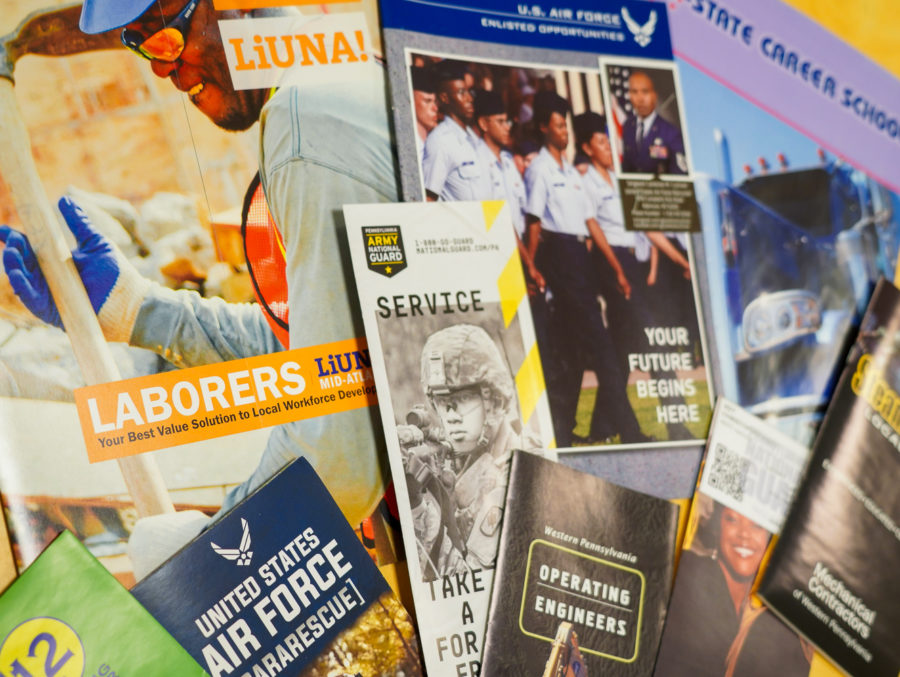Spring is here, arriving with some much-needed color in Pittsburgh’s grayscale environment, allergy season, and a load of fresh beginnings–many in the form of decisions about the future.
It is the season of “Do we know where we’re going yet?” and “What’s the plan now?” It’s the time for calling up one’s close relations to announce where the next four years will be spent, an awkward period when schoolwork gets pushed to the back of a second-semester senior’s mind to make room for drafting Class of 2026 introduction bios and scheduling campus visits.
However, as dominant as the classic college culture appears to be, just 62% of the nation’s high school graduates choose to attend a four-year college after graduation. The other 38% venturing into extrinsic educational or career pathways.
NASH senior Mia Pursley has her eyes set on veterinary work, but not necessarily through traditional veterinary school.
“After graduating from NA, I am going to attend VTI, [the] Veterinary Technical Institute of Pittsburgh,” she said. “When I finish, I will be a veterinary assistant. Once I pass the boards test, I will be a veterinary technician.”
VTI is one among the many trade school programs across the United States that offer students a more niche, hands-on education towards achieving their career goals. NASH’s high school equivalents are the programs offered through A.W. Beattie Career Center, one of which Pursley has taken advantage of for the past three years.
For students such as Pursley, who are confident in what they want to do in the future, the Beattie to technical institution pathway is a prime fit.
“I want to get out and work as soon as possible,” Pursley said. “I would love to eventually work in a zoo with exotic animals or reptiles. Hopefully, after going to VTI, I can either further my education in that area or start working right away.”
With the fire service, not only are you helping people directly, but you can see the impact you have immediately. That means a lot to me.
— Colton Merriman, NASH senior
Trade schools have been picking up steam in recent years as the financial uncertainty of the COVID-19 pandemic has caused many people to question the value of a four-year degree.
For senior Dominic Obarto, the monetary burden of an undergraduate degree certainly played a factor in his decisions for the future.
“I truly believe trade school is the best for me,” said Obarto, who plans to further his education at Rosedale Technical College and become an electrician. “[There is] not as much student debt and [only] 16 months of school instead of four-plus years of college. You will always have a job, and work will always pay very, very well.”
Perhaps more similar to the “traditional” four-year degree. some high school graduates go on to receive an associate degree. Rather than four years, associate degrees typically require just two years to complete and are focused on developing the fundamental skills for a student’s field of interest.
Associate degrees are common at community colleges and are often paired with an additional educational qualification. For example, students may add two more years of schooling at a larger research university after receiving their associate degree, or as senior Colton Merriman plans to do, simultaneously work towards a degree and a professional certificate.
After graduation, Merriman will attend CCAC to earn an associate’s degree in fire science. At the same time, he will be taking classes at the Allegheny County Police and Fire Academy to earn an assortment of state and national certifications.
The end goal? To work in one of Pittsburgh’s fire departments.
“At first, I didn’t think I could make this path my own,” Merriman confessed. “However, now that I am one year into the fire service, I realize how cool, how unique, and how fun it is. If I could do this as a career, it would make me incredibly happy.”
Many young people who choose to follow pathways that develop their more vocational skills echo Merriman’s reason for forging into the fire service.
“In my opinion, in most careers you are indirectly helping people, if at all. With the fire service, not only are you helping people directly, but you can see the impact you have immediately. That means a lot to me,” Merriman expressed.
Each year, the military attracts interest from around 136,000 high school students, two of whom are North Allegheny seniors Ben Pizon and Taylor Stover.
Stover is a member of the school’s Reserve Officers’ Training Corps (ROTC) and has long had her eye on joining the military.
“I have always wanted to go into the military for as long as I can remember. It was just a matter of figuring out what path to take,” Stover said.
On June 27th, she will ship out to the Navy’s boot camp. In college, she plans to become a member of the construction battalion and go active in the military once she graduates. However, her post-high school plans are dual-faceted, as she also wishes to major in interior design.
It is great to have other options out there besides attending four-year college.
— Mia Pursley, NASH senior
“Being a part of the construction battalion and having a major in interior design will allow me to get into real estate. I not only want to turn this into my full-time job once I retire from the Navy but also into a side job once I am fully active,” Stover said.
Similar to Stover, Pizon will also be taking a Navy-related route for his education, and like Stover, the roots of his post-graduation plans run deep.
“From a young age, I have always held a deep desire for the water, from sailing to fishing with my grandfather,” Pizon recalled.
In addition to this, Pizon’s family holds a long history of military service with one grandfather in the Coast Guard, another in the Army, and an uncle in the Navy.
All of this led Pizon to commit to the United States Naval Academy in Annapolis, Maryland where he will graduate with a Bachelor of Science in Naval Architecture and Marine Engineering. After attending the USNA, he will also earn commissions as an ensign in the Navy or a second lieutenant in the Marine Corps.
Despite the minimum five years of Navy or Marine Corps service USNA graduates are required to complete, Pizon is steadfast in his decision.
“I want to use my leadership experiences to challenge myself, expand my leadership skills, and serve [while] being a part of a team and something greater than myself,” he said.
In educational institutions across the country, seniors are buckling down for their last few weeks of high school and gearing up to start the rest of their lives.
Those preparations may look like booking college campus visits, scouring Facebook profiles for a potential roommate, and making shopping lists for dorm room decorations, or they may look like training at a military boot camp, deciding which professional tools to pack, and refining class schedules at both a college and a fire academy.
For those heading in a non-typical direction after high school, their career timelines may veer from what most of us expect after a high school education. However, the variety of options before them has allowed these students to pursue the path best fit for who they are and what they want.
As Pursley stated, “It is great to have other options out there besides attending four-year college.”
This story was originally published on The Uproar on April 18, 2022.































![IN THE SPOTLIGHT: Junior Zalie Mann performs “I Love to Cry at Weddings,” an ensemble piece from the fall musical Sweet Charity, to prospective students during the Fine Arts Showcase on Wednesday, Nov. 8. The showcase is a compilation of performances and demonstrations from each fine arts strand offered at McCallum. This show is put on so that prospective students can see if they are interested in joining an academy or major.
Sweet Charity originally ran the weekends of Sept. 28 and Oct. 8, but made a comeback for the Fine Arts Showcase.
“[Being at the front in the spotlight] is my favorite part of the whole dance, so I was super happy to be on stage performing and smiling at the audience,” Mann said.
Mann performed in both the musical theatre performance and dance excerpt “Ethereal,” a contemporary piece choreographed by the new dance director Terrance Carson, in the showcase. With also being a dance ambassador, Mann got to talk about what MAC dance is, her experience and answer any questions the aspiring arts majors and their parents may have.
Caption by Maya Tackett.](https://bestofsno.com/wp-content/uploads/2024/02/53321803427_47cd17fe70_o-1-1200x800.jpg)
![SPREADING THE JOY: Sophomore Chim Becker poses with sophomores Cozbi Sims and Lou Davidson while manning a table at the Hispanic Heritage treat day during lunch of Sept 28. Becker is a part of the students of color alliance, who put together the activity to raise money for their club.
“It [the stand] was really fun because McCallum has a lot of latino kids,” Becker said. “And I think it was nice that I could share the stuff that I usually just have at home with people who have never tried it before.”
Becker recognizes the importance of celebrating Hispanic heritage at Mac.
“I think its important to celebrate,” Becker said. “Because our culture is awesome and super cool, and everybody should be able to learn about other cultures of the world.”
Caption by JoJo Barnard.](https://bestofsno.com/wp-content/uploads/2024/01/53221601352_4127a81c41_o-1200x675.jpg)






